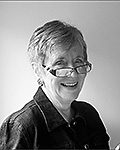Kay Gillies Dixon — A Kennedy Kid in Colombia Three
My PCV partner Dee and I were congratulating ourselves. We had just demonstrated preparing CARE powdered milk sweetened with panela to a mothers’ class at our barrio health center. The women were finally beginning to use CARE food products to nourish their families rather than selling their allotments at the local markets. It has taken nearly a year to reach this goal.
We had packed our supplies and departed the health center, walking to our apartment for lunch. Dona Graciela, a barrio busybody if ever there was one, came running toward us, tears streaming down her face. Several street children were part of her entourage. “Su presidente ya esta muerto! Esta muerto!” she sobbed.
“Esta en my televisor. Es la verdad.”
Unable to believe what Dona Graciela was telling us, we dropped our baskets at our doorstep and followed to her home. She shooed away her other family members and pulled chairs for us directly in front of the small black and white television. We heard and saw Walter Cronkite with a tear in his eye announce the death of President Kennedy, then followed the video of the fatal motorcade. Mesmerized we sat there watching as the video played and replayed.
After a while we returned to our apartment and turned on our transistor radio hoping for any positive news. Time stood still. All our commitments stopped. We found ways to connect with the other Volunteers who lived in Medellin, one group had a short wave radio and was able to hear the latest updates. In the days that followed, as we navigated through the city, everywhere United States and Colombian flags were at half mast, black bunting hung and draped over doorways, over windows, around signs and on the busses’ indicator destinations.
Eventually we PCVs in Medellin made our way to the American Consulate’s office to sign a Condolence book for President Kennedy; we learned this was the appropriate way to honor a deceased world leader.
President Kennedy represented hope for our generation. Colorful personality from a political and wealthy New England family, a refreshing face in my universe. I actually saw him once when I was in Peace Corps training. His escorted motorcade was racing to the airport, he was riding high on an open convertible back through my New York City slum. I vigorously waved both arms to him, he grinned and waved back to me. Giant goose bumps. The President of the United States had waved to me. Seeing him and his young family on television news programs, he was my future, he spoke to me and for me. I was a Kennedy Kid, the disparaging nickname for PCVs.
Coming from a small town in conservative western Pennsylvania, I learned about politicians and elections from the local newspaper or television news. My family was not active in either of the major parties’ national politics, although my parents probably voted in all the elections. It would be the respectable action to take. I knew they had not supported President Kennedy.
As a small player in this international experiment, my world expanded exponentially when national figures from both political parties interacted with Peace Corps groups. My work site in an urban program just five minutes from the city’s airport was a frequent stopping point for members of Congress traveling to explore Latin America for their pet projects. Medellin is a particularly attractive city in Colombia, definitely a city to visit. For Congressmen to be able to say they had visited a Peace Corps site justified the expense of their fact finding mission, whatever their mission.
In my high school through college years, service to community was a constant. Small fund raising projects, spaghetti suppers, bake sales, candy bar sales, walks or bicycle rides for charity, these social activities were as much as providing service to the “cause de jour.” Now living among impoverished peoples, I saw my small endeavors as part of a larger initiative to improve local conditions. In my barrio, working with teen agers and soccer fans to help clear a field of weeds and garbage for a soccer field, fostering organizational development. Our partner led an initiative to reduce the rat population in the barrio, at least to rid his street and house of the infestation. Rats were the size of cats. Small projects to be sure, but we understood small successes would lead the way to greater success.
Now, what would happen to the program? Would Peace Corps continue? We did not expect to be called home, but we did not know. Some PCVs were queried, “Will you go back to your country? For the revolution?”
At that time, my thoughts focused on the world at large. World peace was my ambition, to play a small part in bringing about world peace.
The Kennedy Assassination is nearly ancient history today, it happened sixty years ago. Truly a life time. Asked to write about my experience that day, the story unfolded as if it had occurred yesterday. Such was the impact on my 22 years of life.
•
Kay Gillies Dixon has published two books of memoir Wanderlust Satisfied and the 2017 Peace Corps Writers Best Travel Book Tales of Family Travel. With her husband Kevin, she relocated from Cape Cod to Spokane, Washington, to be near their grandchildren.

So vivid. Thank you for this!
Oops! I was NOT a member of the Colombia One Peace Corps Group. Colombia One was an all male group focused on rural Community Development and they were AWESOME. I was in Colombia Three, the first group to include women and our focus was urban community development.